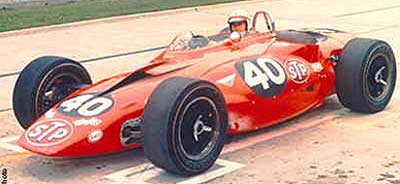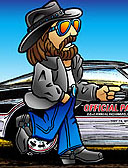
The Spirit of Andy Granatelli’s 1967 Indy 500 Race car lives on in a 1978 Turbine-Powered Corvette.
By K. Scott Teeters, illustrator and author of Vette Magazine’s The Illustrated Corvette Series
Did Chevy ever seriously consider a turbo-powered Corvette?
Car designers have been playing around with the notion of a turbine-powered car since the dawn of the jet age. Chrysler stunned everyone in ’63 with their Ghia-built, bronze Chrysler Turbine Car. At the ’64 – ’65 New York World’s Fair you could actually take a slow ride in the bronze beauty. So the question for Corvette lovers is, “Did Chevy ever seriously consider a turbocharged Corvette?” The short answer is, “NO!” They may have talked about it over lunch, but Chevy never got into the turbine craze of the late ’60s.

Parnelli Jones drove the STP Turbine Indy Car to a heart breaker,with a $20 bearing putting the car out with just 2 laps to go! The turbine engine sat NEXT to Parnelli!
STP sponsored Indy 500 racer
In 1967, however, Andy Granatelli floored the racing world with his STP sponsored Indy 500 racer. The car was built in total secret and was completely in line with Indy 500 racing rules, so they couldn’t preclude the car from racing. Parnelli Jones drove the 550-horsepower Pratt & Whitney-powered, four-wheel-drive racer and SMOKED everyone on the track that day. That is, until a $20 bearing broke on the second to last lap, costing the team the race.
The following year, Granatelli came back with a wedge-shaped STP sponsored turbine racer. But the Indy 500 rules makers caved to pressure and placed so many restrictions on turbine-powered Indy racers that they were no longer competitive. Thus ended the short and very interesting era of the Indy turbine cars. Since then, turbine-powered cars have been not much more than a novelty act.
By the late ’70s, Andy Granatelli’s son, Vince, was running “The Pit Stop Service” shop in Van Nuys, California. Friend Herb Orlowitz, owner of Corprajet Leasing, loved fast jets and commissioned Granatelli to build him a fast, turbine-powered car.

Same unit that Granatelli used in the ’67 Indy turbine car
The Corvette was chosen because it was the only car they could find that would accommodate the long turbine engine. The engine, by the way, was the same unit that Granatelli used in the ’67 Indy turbine car. The front end of the car is essentially a shell to cover the engine. Talk about a lowly start, the Pratt & Whitney turbine engine was originally designed to be a power generator for oil drilling rigs. (Kind of like the trash compactor character in the film, “Wall-E”)
Granatelli connected the turbine engine to a modified GM Turbo 400 automatic transmission with a beefed up drive shaft. Exhaust for the car was tricky. The single exhaust vent of the turbine was connected to a wide, shallow box that was mounted under the car. Turbines flow a tremendous amount of air, precluding any kind of tubular exhaust system. The exhaust vent at the rear was as wide as the underside of the car. The heat coming out of the back of the car must have been stupendous. That s one way to discourage tailgaters!
The rear luggage space was taken up with 6 car batteries required to spark the engine alive. The stock Corvette disc brakes were replaced with heavy-duty NASCAR vented racing brakes. After the car was started, driving technique around town consisted of lifting your foot off the brakes to let the car move forward. (That must have taken some getting used to) The exterior of the car was completely stock with silver and black paint, factory front and rear spoilers, and Centerline wheels. For an odd-ball car, it was very good looking.
How Fast?
After all that, “how fast,” you ask? The first day at the drag strip crunched the drive shaft. With a repaired drive shaft and a soft launch, the turbine Vette ran the quarter-mile in 12.0-seconds at 111 mph. The claimed top speed was 180 mph. The total cost of the car was never published, but you can guess that it was A LOT! Motor Trend magazine covered the car in the November ’79 issue. To the best of my knowledge, that was the only ink the car ever received.
When I was researching this car in the Net, I was surprised to find nothing, zero! Not a mention or an update as to the car’s whereabouts. So, if you know anything about this Odd-Ball Corvette, I’d love to know and will publish an update. I did find two cool videos for you to enjoy, though. The first shows the Turbine Engine running and the second gives you a detailed display of the actual turbine engine. Enjoy!
– Article By K. Scott Teeters
K. Scott Teeters is an artist and writer of the the popular Illustrated Corvette Series column as seen in Vette magazine since 1997.
Enjoy more of Scott’s articles and sign up for his Free Illustrated Corvette Series Corvette Engine Spotters Guide Ebook at www.corvettereport.com.
His Corvette art can be found at www.illustratedcorvetteseries.com.
Save the Wave,


There were a lot of articles on this car in its era. Autoweek did a feature on it – and an even better one on the ultimate sleeper, Granatelli’s turbine powered IMPALA. Looked completely stock on the outside, just like the ‘vette.
By the way, the article implies that there was more than one ‘vette and more than one Impala. Granatelli goes on to explain how he more or less ran some fool off the road who dared challenge him while he was driving the Impala. It was my understanding that the Impala has the same “Indy” turbine as the ‘vete.
I’d love to drive either one.
I “might” have that AutoWeek article. I’ll have to find the Turbine Corvette owner’s email and asking him about the other Granatelli turbine cars. A “Turbine Impala” Hmmm… talk about a SLEEPER. Imagine some young dudes in a rice burner trying to tell their pals, “No man! The big old fart’s car sounded like a JET! REALLY Dude!” I’ll get back to you if I learn anything about the “other” turbines. – Scott